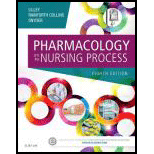
To describe:
The anatomy of the ear including the external, middle, and inner ear.
Concept introduction:
The ear is an organ that is involved in the hearing the external sounds. It is made up of four parts, namely the external ear, the outer ear, the middle ear, and the inner ear. The ear disorders were categorized based on the affected part or portion of the ear. The outer and the middle ear are commonly affected due to the earwax accumulation, inflammation, bacterial, and fungal infections.
Explanation of Solution
External and outer ear:
The external ear comprises an outer projecting part called the pinna and the opening of the ear canal. The pinna is also termed as the auricle and ala. The outer ear is also referred as the external auditory canal. It is a space between the tympanic membrane (ear drum) and the external auditory meatus through which the sound waves are passed into the inner regions of the ear.
Middle ear:
The middle ear is made up of the tympanic cavity. It is a space that starts with the tympanic membrane and ends in the oval window. It also comprises three mastoid bony structures and eustachian or auditory tubes. The three bony structures are the malleus (hammer), incus (anvil), and stapes (stirrup).
Inner ear:
The inner ear is the innermost part of the ear and it consists of two main parts such as cochlea, which is the hearing organ and semicircular canals, which is the balancing organs.
The inner, middle, and external anatomy of the ear are discussed.
Want to see more full solutions like this?
Chapter 58 Solutions
Pharmacology and the Nursing Process, 8e
- Discuss Hypertension under the following headings: Definition Diagnosis Non-pharmacological intervention Drugs Classification Management of a Hypertensive emergencyarrow_forwardExplain how the answer could be 2 or 1.8 WITHOUT changing the questionarrow_forwardoverview of the neurological system, cranial nerves and what part of the body it innervatesarrow_forward
- differentiate structure and function of the peripheral vascular system. what are the normal and abnormal findings of the peripheral arterioles and peripheral venous systemarrow_forwardAn overview of the skin, hair and nails epidermal appendages normal and abnormal findingsarrow_forwarddifferentiate the twelve cranial nerves and how to test themarrow_forward
- What are the nursing interventions for patients with GI problems ? What is the priority ?arrow_forwardAdult Nutrition Assessment Date of consultation: 3/2/25 Reason for Nutrition Assessment: Mrs. Clover was referred to the RD from the ER physician; patient experiencing weight loss, SOB & Edema Nutrition Assessment Data 69 YOF Ht 157 cm, Wt 53 kg. BMI 21.7 Usual wt 55 kg Heart: slight physiologic murmur; lungs: clear; extremities: 3+ edema to bilateral lower legs; elevated BP, abdomen: soft, nontender, active bowel sounds; neurologic: unremarkable; skin: diminished skin tugor. Biochemical Data BUN 72, Creatinine 4.6, Calcium 7.2, Phosphorus 7.3, glucose 105, BNP 720, Albumin 2.0, Na 125, K 3.3, CI 93. Hgb 11.5, Hct 33.2, ALT 29, AST 36, Alkaline phosphatase 120, other relevant labs pending result. Medications Include inhalers, Cymbalta, Neurontin, Seroquel, and topiramate, prilosec, solumedrol, rocephin, zithromax, NaCl 0.45%+50 MEQ sodium bicarbonate @100 ml/hr. No history of herbal supplements. Since her pneumonia diagnosis several days ago, she has felt too weak to prepare meals, she…arrow_forwardAssuming you are a community health nurse, choose a community of your own and perform practically the following and report your findings: a. Community Assessment b. Community Diagnosisarrow_forward
- Describe practically how you would use a standing order in the diagnosis and treatment of a 10-year-old primary school pupil with a complaint of haematuria at the end of the urine.arrow_forwardSimple explanations, please. B. Why is an accurate diagnosis of malnutrition important? H. Is BMI a food indicator of malnutrition? I. Can an overweight/obese patient develop malnutrition? Why or why not?arrow_forwardHow is the severity of malnutrition determined based off the table? Simple explanation please.arrow_forward
 Phlebotomy EssentialsNursingISBN:9781451194524Author:Ruth McCall, Cathee M. Tankersley MT(ASCP)Publisher:JONES+BARTLETT PUBLISHERS, INC.
Phlebotomy EssentialsNursingISBN:9781451194524Author:Ruth McCall, Cathee M. Tankersley MT(ASCP)Publisher:JONES+BARTLETT PUBLISHERS, INC. Gould's Pathophysiology for the Health Profession...NursingISBN:9780323414425Author:Robert J Hubert BSPublisher:Saunders
Gould's Pathophysiology for the Health Profession...NursingISBN:9780323414425Author:Robert J Hubert BSPublisher:Saunders Fundamentals Of NursingNursingISBN:9781496362179Author:Taylor, Carol (carol R.), LYNN, Pamela (pamela Barbara), Bartlett, Jennifer L.Publisher:Wolters Kluwer,
Fundamentals Of NursingNursingISBN:9781496362179Author:Taylor, Carol (carol R.), LYNN, Pamela (pamela Barbara), Bartlett, Jennifer L.Publisher:Wolters Kluwer, Fundamentals of Nursing, 9eNursingISBN:9780323327404Author:Patricia A. Potter RN MSN PhD FAAN, Anne Griffin Perry RN EdD FAAN, Patricia Stockert RN BSN MS PhD, Amy Hall RN BSN MS PhD CNEPublisher:Elsevier Science
Fundamentals of Nursing, 9eNursingISBN:9780323327404Author:Patricia A. Potter RN MSN PhD FAAN, Anne Griffin Perry RN EdD FAAN, Patricia Stockert RN BSN MS PhD, Amy Hall RN BSN MS PhD CNEPublisher:Elsevier Science Study Guide for Gould's Pathophysiology for the H...NursingISBN:9780323414142Author:Hubert BS, Robert J; VanMeter PhD, Karin C.Publisher:Saunders
Study Guide for Gould's Pathophysiology for the H...NursingISBN:9780323414142Author:Hubert BS, Robert J; VanMeter PhD, Karin C.Publisher:Saunders Issues and Ethics in the Helping Professions (Min...NursingISBN:9781337406291Author:Gerald Corey, Marianne Schneider Corey, Cindy CoreyPublisher:Cengage Learning
Issues and Ethics in the Helping Professions (Min...NursingISBN:9781337406291Author:Gerald Corey, Marianne Schneider Corey, Cindy CoreyPublisher:Cengage Learning





